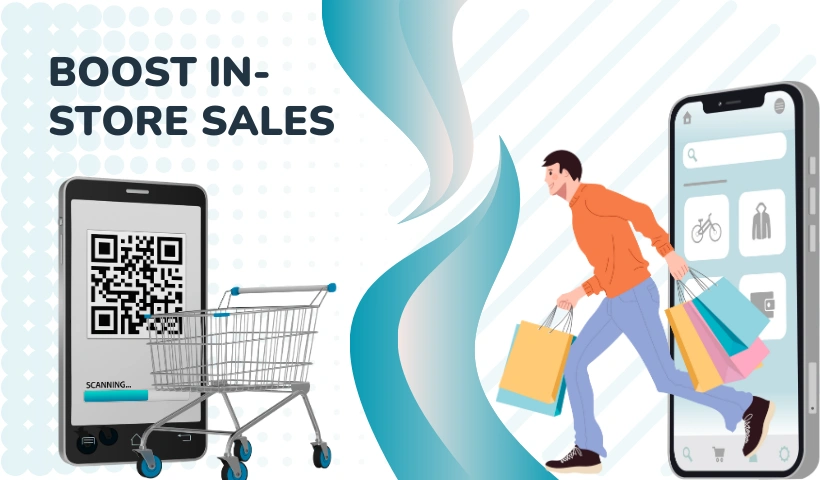Despite the rapid growth of e-commerce, physical retail continues to play a vital role in how customers discover, experience, and purchase products. What sets brick-and-mortar stores apart is their ability to create memorable, sensory-rich experiences that online platforms cannot replicate.
At the same time, today’s shoppers are digitally savvy and expect the same level of convenience in-store as they do online. This is where QR codes prove particularly effective. Simple to implement yet highly versatile, they create a bridge between the physical and digital worlds, offering retailers new ways to engage customers and drive sales.
Here are five ways QR codes can boost in-store sales:
1. Providing Instant Access to Information
One of the biggest hurdles in physical retail is that shoppers often do not have access to the same depth of information they would find online. By placing QR codes on product packaging, signage, or shelf displays, retailers can bridge this gap seamlessly. A quick scan can provide detailed specifications, customer reviews, comparison guides, and even demonstration videos that bring the product to life. This not only saves customers the effort of searching for information on their own but also ensures that the details they receive are accurate and brand-approved.
The ability to access reliable and comprehensive information in real time reduces uncertainty and helps shoppers feel more confident in their decisions. It also allows retailers to educate customers about features they may not have considered, further strengthening the value proposition. In this way, QR codes act as digital sales assistants, empowering customers with knowledge while enhancing their in-store journey and ultimately increasing the likelihood of purchase.
2. Enabling Exclusive Promotions
QR codes can be powerful tools for creating a sense of exclusivity and excitement. By linking codes to special offers, discounts, or bundle deals available only through scanning in-store, retailers can incentivise immediate action. Shoppers feel they are receiving something unique, which not only encourages impulse buying but also enhances the perceived value of their visit to the physical store.
Beyond driving one-off sales, these promotions can also be structured to build longer-term engagement. For instance, codes might lead to limited-time vouchers that encourage repeat visits or seasonal campaigns that reward loyalty. By integrating QR-driven promotions into broader marketing strategies, retailers can spark ongoing customer interest while increasing basket size and store traffic.
3. Reducing Friction at Checkout
One of the most common frustrations in brick-and-mortar retail is the time spent queuing at tills. QR codes offer an elegant solution by enabling scan-and-pay options directly from a customer’s smartphone. This not only speeds up the checkout process but also provides a contactless alternative, which many shoppers now prefer. Faster, smoother transactions reduce the chances of abandoned purchases and improve overall customer satisfaction.
In addition, this approach opens the door to hybrid shopping experiences. For example, customers might scan and pay in-store, but opt for home delivery instead of carrying items with them. Retailers benefit by capturing sales that may otherwise be lost due to inconvenience, while customers enjoy flexibility and choice in how they complete their purchases.
4. Enhancing Loyalty Programmes
Retaining existing customers is often more cost-effective than acquiring new ones, and QR codes can play a significant role in building loyalty. By linking directly to loyalty platforms, codes make it easy for shoppers to sign up, earn points, or redeem rewards without the hassle of filling out forms or downloading apps on the spot. This immediacy increases participation rates and strengthens the bond between customers and the brand.
Moreover, QR-enabled loyalty programmes provide valuable data insights for retailers. By tracking how and when customers engage with codes, businesses can better understand buying habits and personalise rewards. This creates a virtuous cycle where customers feel valued for their loyalty, while retailers can continuously refine offerings to encourage repeat visits and higher spend.
5. Creating Interactive Experiences
Modern consumers increasingly seek more than just products—they value experiences. QR codes can be the entry point to interactive content that enriches the in-store journey. For example, codes placed near clothing racks could lead to digital style guides or video lookbooks, while those in supermarkets might unlock recipes featuring the items on display. These added layers of engagement encourage customers to linger longer in-store and form stronger emotional connections with the brand.
Beyond entertainment, interactive QR experiences can also educate and inspire. Augmented reality (AR) features, sustainability stories, or behind-the-scenes videos can all be delivered instantly to a shopper’s device, deepening brand storytelling. By turning shopping into an experience rather than a transaction, retailers not only boost immediate sales but also build lasting customer loyalty.
Final Thoughts
QR codes are no longer just a convenience tool; they have become a strategic asset for retailers seeking to blend physical shopping with digital engagement. By using them thoughtfully, businesses can increase sales, improve customer satisfaction, and differentiate themselves in an increasingly competitive landscape.
For retailers ready to explore practical solutions, Brevix provides the technology to generate, manage, and measure QR codes with ease—helping you turn every scan into an opportunity for growth.


